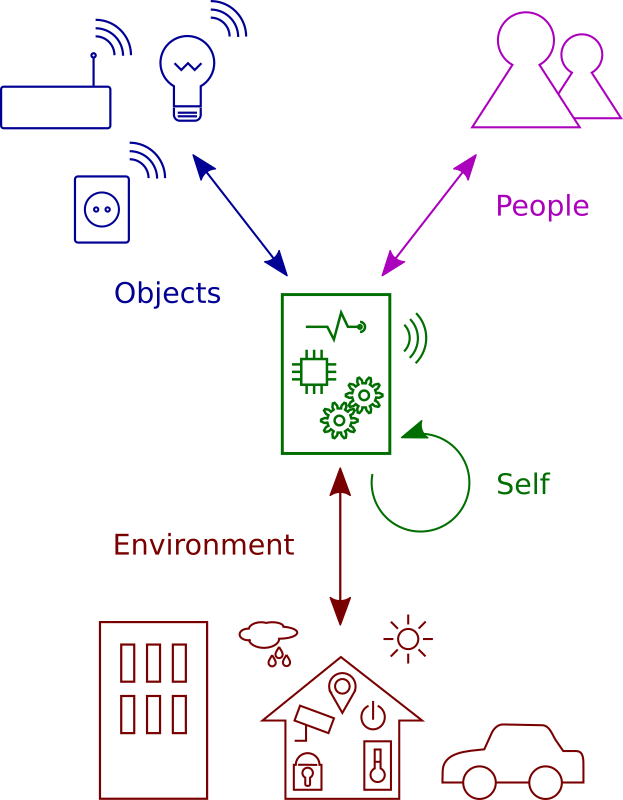by Ivana Šenk (Inria and University of Novi Sad) and James Crowley (Inria)
With the encroachment of smart objects into our lives, it is increasingly important to define a principled approach to estimate the value of alternative technologies at design time, to define product specifications and to compare similar products. In mature domains, such approaches are based on properties that are referred to as “qualities”. We are working to develop a hierarchical model for qualities for smart objects based on different modes of interactions.
What is a quality? Ideally, qualities are distinctive attributes that can be used to characterise things or to provide a standard for their comparison. The effective use of a quality requires an established way to assess it through an objective test. Such tests may be quantitative, providing a numerical value or qualitative, providing a symbolic label. In either case, the test must provide an objective reference for comparison.
The use and measurement of qualities has been studied in a number of related domains, including manufacturing, software engineering, communications, human-computer interaction, multimedia systems and Internet of Things. In general, the study of qualities in each of these domains has given rise to hierarchical conceptual frameworks, with the concept of “quality” being broken down into a variety of more detailed characteristics that can be evaluated with one or more tests.
In many domains, quality dimensions follow similar principles. For example, in manufacturing Garvin [1] proposed eight critical dimensions of quality that serve as a framework for analysis and product evaluation: performance, features, reliability, conformance, durability, serviceability, aesthetics, and perceived quality. Similarly, in software engineering the scientific and industrial communities have developed a variety of quality models, leading to the adoption of ISO/IEC standard 25010 [2], where quality is represented by two major aspects: product quality and quality in use. Product quality includes functional suitability, performance efficiency, compatibility, usability, reliability, security, maintainability, and portability. Quality in use includes effectiveness, efficiency, satisfaction, freedom from risk, and context coverage.
Similar patterns may be found in other domains, where we can find intrinsic qualities such as performance, functionality, conformance, correctness, reliability, efficiency, durability, reusability, maintainability, portability, compatibility, security and privacy; as well as user-related qualities such as usability, learnability, ease of use, naturalness of interaction, understandability, perceived quality, aesthetics, satisfaction, appropriateness, joy of use, usefulness, or trust.
Smart objects have emerged, as ordinary objects are increasingly augmented with digital technologies to provide embedded functions for perception, action, interaction and intelligence. To build a comprehensive quality model for smart objects, we propose to draw on the quality dimensions identified in related domains, and to identify new quality dimensions that take into account the capabilities that arise with smart technologies. Such new capabilities cover the features that make the objects smart, such as connectivity and cognitive abilities. These include abilities for sensing, actuating, interpretation, communication and networking, as well as abilities for easy, natural, and convenient interaction with people. A variety of qualities are possible, although the relative importance may vary with the type of smart objects.

Figure 1: Interaction dimensions of smart objects.
We base our approach on different interaction dimensions of smart objects (Figure 1). We start with the intrinsic dimension that addresses the self-oriented qualities of the smart object, and add three extrinsic dimensions of interaction that the smart objects have with the environment, with other objects, and with people. Accordingly, we propose a hierarchy of detailed quality characteristics along the following main dimensions:
- Innate qualities, related to the core function of the smart object. These include functionality and conformance aspects, as well as qualities that relate to efficiency of the smart object, such as energy management, reliability, and availability, and qualities that take into consideration the product lifecycle, such as durability, maintainability, portability, upgradeability, or recyclability.
- Cognitive qualities, based on abilities to acquire, interpret and apply knowledge and skills. These include conceptual qualities that allow the smart object to behave in a appropriate manner, by perceiving, learning, understanding and reasoning about the environment, and taking relevant actions.
- Social qualities, based on abilities for communication, networking, and inter-object relationships. These include aspects of social interaction between smart objects, from the types of connections that enable interaction to the possibilities that these connections provide. They cover composability through the diversity, capacity, compatibility and extendability of connections, availability of connections through discoverability, accessibility and transitivity, and sociability through the ways of forming relations, inter-object controllability and collaborative ability.
- Suitability qualities, which include the capacity to act and interact with the users in a manner that is appropriate for the task and context. To measure suitability, we reflect upon the usability aspects such as learnability, ease of use, user control, understandability, or predictability, and acceptability aspects, such as privacy, security, trust, aesthetics, engagement, satisfaction, or usefulness.
We are currently working to establish adequate objective ways to test and measure these proposed quality aspects for smart objects. Some of these aspects can be tested under controlled laboratory conditions, while the others require evaluation under real world conditions. In order to assess our quality model we are applying the proposed tests to different types of existing smart objects. Our objective is to promote these ideas as an approach for defining, describing, measuring and comparing smart objects, with details to be refined and developed by the larger community. In addition, as the boundary between smart objects and smart services is increasingly fluid, we believe that any normative reference established for smart objects should also be useful for smart services including those provided by assemblies of smart objects.
References:
[1] D. Garvin: “Competing on the eight dimensions of quality,” Harv. Bus. Rev., 1987.
[2] “Systems and Software Engineering - Systems and Software Quality Requirements and Evaluation (SQuaRE) - System and Software Quality Models,” ISO/IEC 25010, 2011.
Please contact:
Ivana Šenk, Inria, France and University of Novi Sad, Serbia
James Crowley
Inria, France











